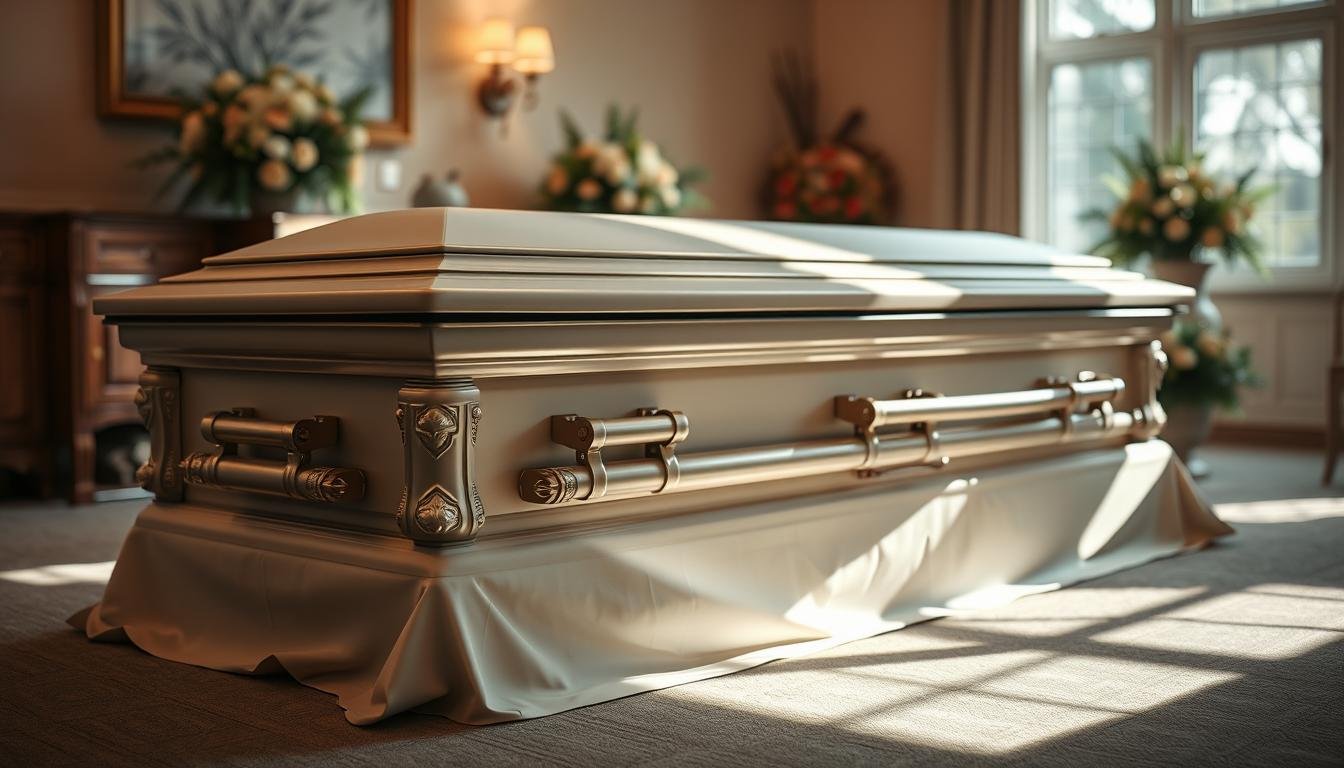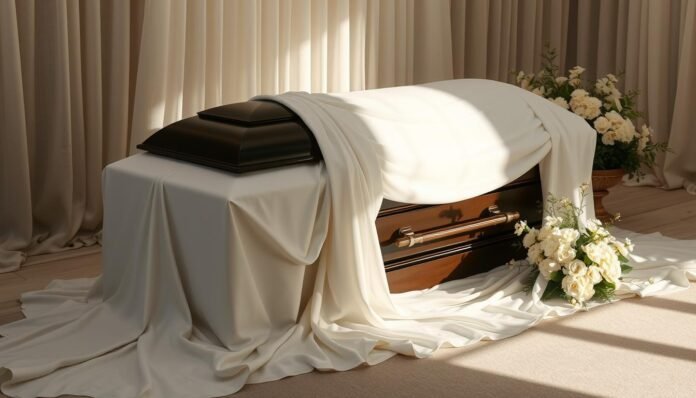“An elegant funeral casket surrounded by soft, flowing drapes that cover the legs, delicate floral arrangements nearby, serene lighting casting gentle shadows, a tranquil and respectful atmosphere, showcasing traditional mourning customs.”
Funeral customs show how we honour our loved ones. Casket covering is a key part of these practices.
It has deep meaning for families during sad times. This tradition is common in many US memorial services.
Casket covering is more than looks. It shows respect and care for the person who died.
These practices reflect our ability to be kind. They show how we honour people in tough times.
Each funeral is a unique way to remember someone. Casket covering helps tell their story.
It’s part of how we say goodbye. Different groups have their ways of showing love.
Understanding Funeral Traditions
Funeral traditions show how cultures honour their dead. They help families deal with loss and remember loved ones.
In the US, funeral customs differ among ethnic and religious groups. Some prefer big services, while others like small gatherings.
Traditions may include unique clothes, readings, or body preparation methods.
Native American tribes have rich funeral customs tied to spiritual beliefs. African American communities often use music to celebrate life.
Jewish and Catholic funerals follow unique mourning protocols.
Learning about these practices helps us understand how people handle grief. Funeral traditions give families a chance to say goodbye.
Today, many blend old customs with new ways to remember loved ones.
The Symbolism of Covering the Legs
Funeral symbolism honours our loved ones. Covering legs in a casket shows dignity in death.
This tradition preserves privacy and respect for the deceased. It reflects our cultural understanding of final farewells.
Different cultures see leg covering as protection and reverence. It creates a sense of peaceful rest.
Funeral directors ensure respectful burials. They carefully arrange fabric around the lower body.
Covering legs marks the transition between life and death. It maintains the deceased’s dignity and personal space.
This practice expresses compassion during grief. It’s a subtle yet powerful way to show care.
Some see it as preparation for spiritual passage. Others view it as a final act of love.
The message is clear: we treat our departed with respect. Funeral symbolism reflects our shared experience of loss.
These practices have deep emotional significance. They help us honour and remember those who’ve passed.
Practical Reasons for Covering the Legs
“A serene funeral home scene, focusing on a beautifully prepared casket with elegant fabric draping over the legs, soft lighting casting gentle shadows, a calm atmosphere, and surrounded by floral arrangements.”
Funeral presentation requires careful attention to detail during casket preparation. Covering the legs enhances the dignity of the funeral service.
Professional funeral directors know how to position the body respectfully. They create a peaceful viewing experience for the family.
Covering legs helps manage how things look during the funeral. Clothing may not drape perfectly, so leg coverings ensure a smooth appearance.
This approach hides any flaws in dress or body positioning, keeping the presentation of the deceased serene and composed.
Casket preparation uses fabric to provide full coverage. These coverings create a sense of peace and completeness.
They protect the body from direct view. This allows family members to focus on remembering their loved ones.
Temperature and preservation are also important reasons for leg coverage. Fabric linings help keep the body looking good during viewing.
Funeral professionals choose materials that match the casket’s design and show the utmost respect for the deceased.
Body positioning is more than just making things look nice. It’s a final act of care that shows respect and compassion.
Families feel comforted knowing every detail honours their loved one’s memory. This attention to detail means a lot during a sad time.
Common Materials Used for Casket Linings
Funeral standards guide the choice of casket fabrics. These materials offer comfort and honour to the deceased.
Silk is a classic pick for casket linings. It gives a soft, fancy look that families like.
Velvet is also popular for caskets. It adds a rich feel to the inside.
Cotton and polyester blends are tough and cheap. They stay neat during funeral events.
Some families choose special linings. These can show the person’s likes or passions.
Funeral rules now allow more fabric choices. This helps honour the unique life of the deceased.
Casket fabric choice depends on family wants. Cultural customs and money also play a role.
Funeral directors help families pick the right fabric. They make sure it fits both feelings and needs.
The Role of the Funeral Director
Funeral directors guide families through funeral planning. They handle delicate tasks with respect and sensitivity.
These professionals manage every detail of preparing the deceased. They ensure cultural and personal preferences are carefully honoured.
Funeral directors carefully prepare the body for presentation. They respect family wishes and understand specific customs.
During grief, funeral directors become trusted advisors. They help select casket linings and provide emotional support.
Their expertise covers practical arrangements and emotional guidance. This makes them essential partners in the funeral process.
Funeral directors coordinate transportation and manage paperwork. They support bereaved families during difficult times.
They ensure that funerals reflect the unique life of the deceased, and their work provides comfort during moments of profound loss.
Questions People Often Ask
Funeral FAQs about casket preparation can be complex and emotional. Many families wonder about leg coverage during burial.
Funeral directors often answer questions about this delicate aspect. Customs can vary based on cultural and personal preferences.
Burial customs explained through professional guidance help people understand traditions. Some ask why legs are covered in caskets.
They seek clarity about practical and symbolic reasons. Answers can provide comfort during a challenging time.
Casket preparation questions often involve material choices and cultural significance. Professionals suggest discussing family wishes with funeral directors.
Each funeral service honours a loved one’s memory. It respects their preferences and cultural backgrounds.
Families often seek reassurance about funeral customs and their meaning. Understanding these practices can help reduce anxiety.
Professional funeral services aim to provide compassionate support. They help create a meaningful farewell for the individual.
FAQ
Why do funeral homes cover the legs in a casket?
Funeral homes cover legs in caskets for dignity and privacy. This creates a peaceful presentation for mourners to view.
Is covering the legs in a casket a universal funeral tradition?
This practice is common in Western cultures. However, funeral customs vary across different regions and cultural backgrounds.
Do all caskets have leg coverings?
Casket interiors can differ based on type and family preferences. Some have elaborate linings, while others have more straightforward coverings.
Can families choose different leg coverings?
Families can work with funeral directors to customize casket interiors. They may pick fabrics, colours, or styles that reflect the deceased’s personality.
Are there practical reasons for covering legs in a casket?
Covering legs helps with body positioning and creates a uniform appearance. It can also hide physical changes that occur after death.
Do different religions have specific views on casket leg coverings?
Religious practices vary widely on body preparation and presentation. It’s best to consult with a spiritual leader or funeral director.
What materials are typically used to cover legs in a casket?
Soft fabrics like velvet, satin, or silk are common choices. Funeral homes use high-quality materials that create a respectful appearance.
you may also read : EntretTech.org: Your Gateway to Innovation & Business Tech Solutions
